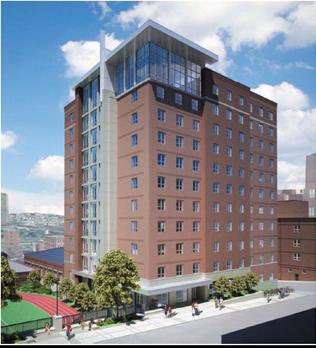
|
User Note: While great efforts have been taken to provide accurate and complete information on the pages of CPEP, please be aware that the information contained herewith is considered a work‐in progress for this thesis project. Modifications and changes related to the original building designs and construction methodologies for this senior thesis project are solely the interpretation of Peter Edwards. Changes and discrepancies in no way imply that the original design contained errors or was flawed. Differing assumptions, code references, requirements, and methodologies have been incorporated into this thesis project; therefore, investigation results may vary from the original design.
This Page was last updated on 4/19/2011, by Peter Edwards and is hosted by the Architectural Engineering Department © 2010 |















|
PRELIMINARY THESIS RESEARCH |
|
Mumma, Stanley. "Overview of Integrating Dedicated Outdoor Air Systems with Parallel Terminal Systems.” ASHRAE Transactions. 107.AT‐01‐7‐1 (2001): 545‐552. Print.
This article discusses the various benefits of using a 100% outdoor air system in comparison to a more conventional variable air volume system. It also explains the different applications of a DOAS system in a building and provides an overview of the different parallel terminal units that can be used to meet the sensible loads in the building.
Jeong, Jae‐Weon, Stanley Mumma, and William Bahnfleth. “Energy Conservation Benefits of a Dedicated Outdoor Air System with Parallel Sensible Cooling by Ceiling Radiant Panels.” ASHRAE Transactions. 109.KC‐03‐7‐1 (2003): 627‐636. Print.
This article explains why ceiling radiant cooling panels are the best choice for parallel sensible cooling in a dedicated outdoor air system. It does this by comparing the energy modeling results and actual energy consumption figures of a radiant cooling system to the other alternatives.
Mumma, Stanley and Yizai Xia. “Ceiling Radiant Cooling Panels Employing Heat Conducting Rails: Deriving the Governing Heat Transfer Equations”. ASHRAE Transactions 2006, Vol. 112 Pt. 1: 34-41. Print. This article provides an overview of the different types of overhead hydronic radiant cooling systems and derives governing heat transfer equations that can be used to determine the cooling capacity of a given radiant cooling panel.
Beckman, Duffie. “Solar Engineering of the Thermal Processes”. 2006. John Wiley and Sons, Inc. This textbook covers the newest developments in solar energy technology by providing a current overview of the governing principles, functioning, design and economics of solar thermal processes.
Apricus Solar Co., Ltd. 2010. Apricus Solar Hot Water. “What is Solar?”. Retrieved from http://www.apricus.com. This website provides technical information on the different types of solar hot water systems and the priniciples behind solar energy. It also has information on the various products that the company makes and some background information on all of the products.
2008 ASHRAE Handbook, HVAC Systems and Equipment. American Society of Heating, Refrigeration and Air Conditioning Engineers, Inc. Atlanta, GA.
2007 ASHRAE Handbook, HVAC Applications. American Society of Heating, Refrigeration, and Air Conditioning Engineers, Inc. Atlanta, GA.
MacKenna, Ella. 2010. “Natural Daylighting for Health and Energy Efficiency”. Retrieved from http://hubpages.com.
Brown, Jerry. 2010. “Controlled Natural Daylight the Biggest Benefit of Green Buildings?”. Retrieved from http://www.brownongreen.net. The two articles listed above discuss the many benefits that controlled natural daylighting has for the occupants of a building. It also talks about the health and psychological benefits that increased daylighting can have and why daylighting has been incorporated into the LEED certification guidelines.
|
|
References for Final Report |
|
2007 ASHRAE Handbook, HVAC Applications. (2007). Atlanta, GA: American Society of Heating, Refrigeration and Air Conditioning Engineers, Inc.
ASHRAE Standard 62.1-2007: Ventilation for Acceptable Indoor Air Quality. (2007). Atlanta, GA: American Society of Heating, Refrigeration and Air-Conditioning Engineer, Inc.
ASHRAE Standard 90.1-2007: Energy Standard for Buildings Except Low-Rise Residential Buildings. (2007). Atlanta, GA: American Society of Heating, Refrigeration and Air-Conditioning Engineers, Inc.
2008 ASHRAE Handbook, HVAC Systems and Equipment. (2008). Atlanta, GA: American Society of Heating, Refrigeration and Air Conditioning Engineers, Inc.
What Is Solar? (2010). Retrieved December 10, 2010, from apricus.com: http://www.apricus.com
(2011). Retrieved March 15, 2011, from Database of State Incentives for Renewables and Efficiency: http://dsireusa.org
AISC. (2008). Steel Construction Manual. Chicago, IL: American Institute of Steel Construction.
ASHRAE. (2007). ASHRAE Standard 62.1-2007: Ventilation for Acceptable Indoor Air Quality. Atlanta, GA: American Society of Heating, Refrigerating and Air-Conditioning Engineers, Inc.
Brown, J. (2010). Controlled Natural Daylight the Biggest Benefit of Green Buildings? Retrieved December 10, 2010, from brownongreen.net: http://www.brownongreen.net
Jae-Weon Jeong, S. M. (2003). Energy Conservation Benefits of a Dedicated Outdoor Air System with Parallel Sensible Cooling by Ceiling Radiant Panels. ASHRAE Transactions, 109(KC-03-7-1), 627-636.
MacKenna, E. (2010). Natural Daylighting for Health and Energy Efficiency. Retrieved December 10, 2010, from hubpages.com: http://www.hubpages.com
Mumma, S. (2001). Overview of Integrating Dedicated Outdoor Air Systems with Parallel Terminal Systems. ASHRAE Transactions, 107(AT-01-7-1), 545-552.
Rea, M. S. (2000). The IESNA Lighting Handbook: Reference and Application. New York, NY: Illuminating Engineering Society of North America.
Stanley Mumma, Y. X. (2006). Ceiling Radiant Cooling Panels Employing Heat Conducting Rails: Deriving the Governing Heat Transfer Equations. ASHRAE Transactions, 112, 34-41.
William Beckman, J. D. (2006). Solar Engineering of the Thermal Processes. John Wiley and Sons, Inc.
|
|
Peter Edwards |
|
Contact: pie5002@psu.edu |
|
PITTSBURGH, PA |
|
Architectural Engineering |
Mechanical Engineering |
The Pennsylvania State University |
|
DUQUESNE UNIVERSITY |